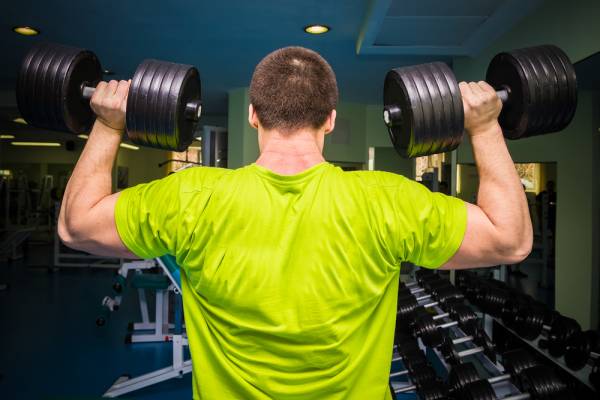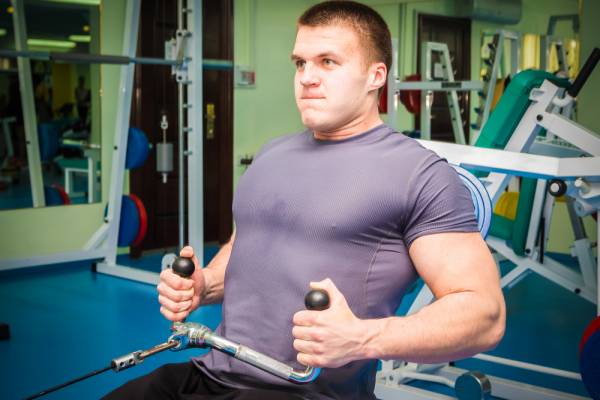You want better gains from your workouts. I know you do. We all do. But I promise you, if you aren’t optimizing any of the following three factors, your gains aren’t what they could be.
While there are scores of variables that go into an effective muscle-building workout, I am going to focus on three often-overlooked aspects: the negative (lowering) part of the rep, the time under load, and getting a pump.
Do Those Negatives Slowly
Muscle hypertrophy is the process of individual muscle fibers increasing in diameter, i.e. getting thicker. Muscle fibers are stimulated to get thicker with repeated and intense muscular contractions. This work produces small microtears, which attract all the growth elements necessary for full repair and growth. So this muscle damage correlates positively with size gains.
But when it comes to negatives, you won’t maximize muscle damage without performing your negatives in a controlled fashion. How slowly do you need to do them for maximum benefit? I usually advise trainees to ensure their negatives are done a little slower than their positives. The positive part of a repetition should take around one second to perform, with the negative coming in around two or three seconds for maximum growth stimulation.
But as a trainer, I don’t want you counting seconds as you train. It’s a huge distraction. So, here’s my best advice on this. You can get the job done by burning this phrase into your mind so it stays there permanently: “Lower the weight under full muscular control.”
Before every set, repeat this phrase to yourself. Soon it’ll become part of your training mind-set. Once you’ve locked this in, the body will follow suit, because the mind leads and the body follows.
Get Your Time Under Load Correct
Remember that we want our bodies to make the anaerobic adaptation of increasing the size of our muscle fibers, and in particular, the fast twitch fibers. Stimulating this process is best facilitated with sets that last anywhere from as little as twenty seconds right up to about a minute long.

This means that for each and every set you should select a weight that causes you to reach positive failure at anywhere between twenty and sixty seconds. If you are using a weight that you can contract against for over sixty seconds, it’s too light and your aerobic system will be generating a large portion of the energy requirements.
If the weight is so heavy that you can’t even work with it for at least twenty seconds, it’s not going to be optimal for those of you prioritizing size gains. This is because although you will recruit the required muscle fibers and limit fatiguing lactic acid, what won’t be optimized is something called rate coding.
Rate coding is the frequency of the contraction signal sent to the motor units. Increased coding means a higher frequency of signals. A higher frequency allows the muscle to generate more force. Training at very low rep ranges or a low time under load doesn’t give this a chance to happen.
So we’ve got this sweet spot of twenty to sixty seconds. How does this translate to reps per set? What does the research have to say about this? A 2007 meta-analysis found that lifting 60%-85% of your one rep max is the best way to stimulate hypertrophy. That comes to about 6-12 reps per set.
The National Strength and Conditioning Association’s position echoes this:
“Shorter bouts of anaerobic training (2 to 4 repetitions) are best for improving muscle power, moderate bouts of anaerobic training (5 to 6 repetitions) are best for building muscle strength, and longer bouts of anaerobic training, 8 to 12 reps per set, are best for increasing muscle hypertrophy.”
In my own training program, my trainees work from a low of 6 reps per set, up to a high of 12 reps per set.

Get a Pump?
Is the pump merely cosmetic, or is it a sign that growth has been stimulated? Well, neither. You could certainly work up a pump without having stimulated any actual growth. However, that’s not to say that it’s useless (albeit nice to look at). A pump is one factor out of many that a trainee can take as positive reinforcement that growth has been stimulated.
Here’s why: The pump is the result of liquid rushing into the muscle cells in order to transport fuel and oxygen to the area. As muscle cells swell, the swelling is perceived as a threat by the body (remember muscle growth is a defense mechanism of the body) and in order to compensate, protein synthesis levels are increased as a means of protection. Also note that it is our fast twitch fibers that primarily respond to this stimulus (fast twitch fibers produce the most growth).
But a pump can also stimulate the mitochondria (power generators) inside the cells to increase in size. So there are different ways in which a pump may contribute to size gains, and why hypertrophy-seeking trainees should favor that sweet 8-12 reps per set range, as opposed to very low or very high rep ranges.
So the bottom line is that you can’t rely on a pump as proof that growth was stimulated, but it is one contributing factor out of many. And you can enjoy the look while it lasts.
References:
1. M. Wernborn et al., “The influence of frequency, intensity, volume and mode of strength training on whole muscle cross-sectional area in humans.” Sports Medicine 2007;37(3):225-64.
Photos courtesy of Shutterstock.






